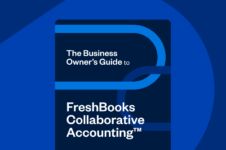Yes! Your side hustle can be more lucrative than ever by making a few simple changes.

Side hustles are a great way to make extra cash on the side and fuel your creative passions. Is it any surprise that they’re on the rise?
Often, though, side hustles aren’t seen as a real job which means people don’t take them seriously and skimp on investing time, money, and resources.
If this is you, I get it. I mean it is just a side hustle and it makes sense to run a tight ship. But here’s the thing, with this way of thinking you’re not doing yourself any favors and the chances are good that you’re making some common accounting and money mistakes (without even knowing it).
Table of Contents
If you’ve ever set a lower rate for your services because it’s “only a side hustle” or told yourself that expense and income tracking could wait till year-end, you know exactly what I’m talking about.
So, in this post, we explore five common side hustle accounting and money mistakes and show you how to fix them with minimal effort (yes, your side hustle can be more lucrative than ever by making a few simple changes).
1. You Don’t Separate Business and Personal Transactions
“For a long time, I deposited my earnings into my main checking account and didn’t really do formal bookkeeping, which meant I didn’t really know how much I was earning.”—Adria Greenhauff, Copywriter
Adria isn’t alone; many freelancers have one account for both personal and business use. If you’re running a side hustle, this is understandable as you may only want to do it for the short term. But, if you’re increasingly thinking about turning it into a full-time job, you may want to keep things separate.
Otherwise, you’ll continuously be sifting through bank statement to determine your earnings and separating business expenses from personal ones. Let’s not forget about the actual impact this has on your business by not knowing where all your money is going.
The Solution
Two separate checking accounts, one for personal use and another for business. Indeed, this is exactly what Adria did and her business is now thriving:
“In the past year, I’ve started keeping everything I make from freelancing in a separate account, paying myself a consistent monthly salary and splitting the rest between business savings and money I allocate toward “operations. This has given me SO much more clarity, allowed me to outsource tasks (which I previously thought I could afford) and overall, given me a new mindset as a real business owner.”
2. You’re Not Tracking Expenses Properly
Many business owners don’t track their expenses and even when they do, they use outdated methods such as Excel. Sound familiar? Tracking expenses with Excel is far better than not tracking your expenses at all. But, if you’ve ever used Excel, you know just how frustrating it can be.
It takes time to manually update spreadsheets as you reconcile numbers from bank statements and a shoebox of receipts. You may even be throwing money away come tax time by incorrectly classifying expenses. Yes, many of your expense items are tax-deductible and you can and SHOULD get money back for that.
That’s not to mention that you never quite know whether your business is even profitable and if you’re actually charging enough for your services.
Just think about it: Imagine you get a job that pays $200 for three hours of work. Your first reaction may be: “This is awesome.” But when you look closer, you realize that you haven’t factored in your expenses and that $200 is, in fact, anything but awesome.
Indeed this is the predicament that current Content Marketing Specialist Chris Chu found himself in when he ran his business as a side hustle. Because of poor expense tracking, he never knew if his business was profitable and if he was charging enough for his services.
But things all changed when he became more serious about his expense tracking: “When I fixed that I was able to look for clients and propose rates that truly reflected my actual worth.”
What Exactly Does This “Fix” Look like?
One solution is to use cloud accounting. With the right cloud accounting solution you can:
- Integrate your bank account for automatic expense tracking to save time
- Easily categorize expenses with tax-friendly business categories
- Rest easy knowing all your documents are safe and secure in the cloud (even if disaster strikes)
- See at a glance what you’re spending your money on thanks to expense reports
- Snap a photo of any receipt with your mobile phone for added convenience
FreshBooks provides all these features and much, much more.
3. You’re Tracking Income and Sending Invoices the Wrong Way
Tracking your income correctly is just as crucial for determining your profitability as expense tracking is. Now, as with expense tracking, your inclination may be to use what’s familiar, i.e., Excel.
But, again there are drawbacks: You spend an awfully long time manually reconciling all the data (as you do with expenses) and don’t have a firm grasp on your income situation. Let’s not forget the difficulty involved in sending an invoice.
How much time do you waste creating an invoice from a template, making calculations, updating dates and even PO numbers? Or what about saving an invoice over another invoice that you’ve stored in a folder ready to access comes tax time?
Do we even need to mention the times you’ve saved an invoice as a PDF and before hitting send you find a mistake, and now have to correct it? Making matters worse, you also discover that instead of fixing that one mistake you have to create a new invoice from scratch because you discarded the invoice template without saving it. “O the joys.”
Dare I mention the old proverb coined by Benjamin Franklin in 1748 that says “Time is Money”? I think so. Time really is money! Because it’s such a valuable resource, we should make an effort to use it wisely. And so, while Excel may seem like the cheaper option, it’s really just a time-suck. There is a better way to track income and send invoices.
What Is This Better Way?
Yes, you guessed it: billing on the cloud! A billing solution like FreshBooks prevents any of those little errors from rearing their ugly heads, ever again. It lets you:
- Track your income on autopilot by integrating with your bank account
- Instantly view summaries of total earnings thanks to income reports
- Effortlessly create beautiful invoices (calculations are made automatically and dates update without you even lifting a finger)
- Quickly set up ONE invoice for subscription-based clients, so you don’t have to create a new invoice each time
- Set automatic late payment reminders without having to remember
- Duplicate an invoice to save time (ideal if your invoice is similar to other invoices)
4. You Don’t Set Aside Enough Money for Taxes
Have you ever been ill-prepared to pay the taxman because you never dedicated a portion of your income for taxes?
Unlike traditional employment, freelancing requires that YOU budget for taxes throughout the year. Unfortunately, many forget to do this and when they’re whacked with a tax bill, they’re left scratching their heads.
Even if you’re running a side hustle, the impact can still be large, as Michigan-based writer Rick Middleton learned. “For many years I didn’t set aside a good portion for taxes. Making an extra $5,000 or $10,000 in a side job can have a huge impact at tax time, and several years I’ve owed money to the IRS.”
The Solution to Your Tax Woes
Here are a few solutions to prepare you:
- Budget for tax dates. If you’re in the U.S., the dates you need to watch out for are April 15, June 15, September 15, and January 15.
- Set aside 25-30% of your income for tax. This is usually more than enough because you’ll have several business expenses that you can write off, but it’s always good to err on the side of caution
- Find an accounting solution, such as FreshBooks that automatically calculates your sales tax on each invoice
5. You Have Below Market Rates
Many adopt an “It’s all gravy” approach while running their side gig. They accept any job under the sun, even if it’s low paying.
It’s easy to fall into this trap as David C Justin discovered: “When I started I took whatever money was offered. I let my clients set the price and I was happy to get $25 for a 500-word blog.”
But here’s the thing, you’re not doing yourself or your industry any favors. By setting or accepting lower rates, you create the perception that these are the going rates in the industry, making it harder for other professionals.
Plus, if you ever decide to turn that side hustle into a full-time gig, you’re going to have to deal with a “reality bites” rate adjustment to make ends meet!
The Solution
Realize that even though you’re running a side hustle, you can and should set higher rates. Research what the going rates are in the industry and price accordingly (reach out to other professionals in your field to see what they charge).
If you’re scared of setting higher rates, it may be because you lack confidence, but it may also be because you don’t truly understand the value you’re providing.
So, get clear on that value (read the book Breaking the Time Barrier; it’s changed how I view my business). If you’re a dog walker, for instance, you’re not just walking someone’s dog, you may be helping out a busy professional who has limited time to do this. Or, if you’re a web designer, you’re not merely designing a website. Your client may want to drive more sales through better design or improve their branding which is outdated.
Once you understand the value, you’ll become far more comfortable charging a better rate. And, if you’re still scared about increasing rates, do it anyways.
When I started my business, my rates were low, but I broke through this by learning what the going rate was and simply just doing. I close my eyes, took the leap, and increased my prices.
You’ll be surprised at what you can achieve when you do that. And yes, I doubled my rates over the course of a month and clients today are more than happy to pay those rates.
Conclusion
Your side hustle is a second source of income. While the sheer nature of running a side hustle means you probably don’t want to invest much of anything into it, there’s no reason why you should be losing money.
But, that’s exactly what you’re doing if you’re making any of these five mistakes. The good news is that you can fix them with minimal effort, time and money so that your side hustle is more lucrative than ever.
And, FreshBooks is here to help you do that. Give FreshBooks a test-drive today. With a free 30-day trial you have nothing to lose.

Written by Nick Darlington, Freelance Contributor
Posted on January 24, 2018

 The Little Wins That Come with Separating Your Personal and Business Finances
The Little Wins That Come with Separating Your Personal and Business Finances
 10 Common Invoicing Mistakes You Can Easily Avoid
10 Common Invoicing Mistakes You Can Easily Avoid




